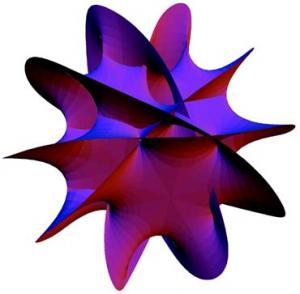The final design for a "doomsday" vault that will house seeds from all known varieties of food crops has been unveiled by the Norwegian government.

|
| ©statsbygg
|
| Artist's impression of the entrance to the vault
|
Comment: Hmmm, wonder how many NeoCon vaults there are out there... (and who keeps that sidewalk clear of snow and ice in the North Pole?)
A fleeting pulse of light has been captured and then made to reappear in a different location by US physicists.
The quantum sleight of hand exploits the properties of super-cooled matter known as a Bose-Einstein condensate.
The emerging pulse was slightly weaker than the high-speed beam that entered the experimental setup, but was identical in all other respects.
The work, published in the journal Nature, could one day lead to advances in computing and optical communication.
The study, reported this week in The Journal of Neuroscience, provides the first direct evidence that humans, like rats, moths and butterflies, secrete a scent that affects the physiology of the opposite sex.
"This is the first time anyone has demonstrated that a change in women's hormonal levels is induced by sniffing an identified compound of male sweat," as opposed to applying a chemical to the upper lip, said study leader Claire Wyart, a post-doctoral fellow at UC Berkeley.
Philip Ball
NatureTue, 06 Feb 2007 15:00 UTC
Lunar colonists could be in for a nasty shock - literally. A team of US scientists has found that the Moon's surface can become charged with up to several thousand volts of static electricity1.
This charging could release sparks that disable electronic equipment - including monitors, space buggies or even the front door of a Moon base. And it could cause dust clouds that clogs up instruments. What's worse, it can be caused by bad weather in space: just when astronauts need their equipment to give them warning and allow them to shelter from the radiation.
US military engineers are looking to bats for inspiration.
Video footage of bats in flight has revealed extreme aerodynamic flexibility of the creature's wings. Bats' wings are made of highly jointed skeletons and elastic membranes, which allow them to generate and manipulate lift in unusual ways.
For their study, researchers Kenneth Breuer and Sharon Swartz at Brown University in Providence, US, used high -speed video cameras to record the 3D wing and body movements of flying lesser short-nosed fruit bats, Cynopterus brachyotis.
Zhan Gao, M.D., Martin J. Blaser, M.D.
PhysorgTue, 06 Feb 2007 08:26 UTC
It appears that the skin, the largest organ in our body, is a kind of zoo and some of the inhabitants are quite novel, according to a new study. Researchers found evidence for 182 species of bacteria in skin samples. Eight percent were unknown species that had never before been described.
It is the first study to identify the composition of bacterial populations on the skin using a powerful molecular method. Not only were the bacteria more diverse than previously estimated, but some of them had not been found before, says Martin J. Blaser, M.D., Frederick King Professor and Chair of the Department of Medicine and Professor of Microbiology at NYU School of Medicine, one of the authors of the study.
Humans learn how to deliberately and carefully reach for things while still in the womb, says an Italian team of scientists.
While it is generally believed babies only show planned reaching behaviour at 3 or 4 months old, the researchers think they may start before they are born.
Psychologist Dr Stefania Zoia of the Institute of Child Health IRCCS Burlo Garofolo in Trieste presented her team's research at the 8th Motor Control and Human Skill Conference in Australia last week.
Jacqueline Hewett
Optics.orgMon, 05 Feb 2007 13:45 UTC
Researchers in Cuba are using an infrared sensor to study the collective behaviour of ants and hope to apply their findings to engineering problems.
Using simple optical components to quantify the behaviour of ants could help scientists tackle problems such as traffic management say researchers at the University of Havana in Cuba. (Review of Scientific Instruments 77 126102)
"Ants show a highly nonlinear, collective behaviour that somehow produces an overall intelligence out of individual simplicity," Ernesto Altshuler from Havana's Complex Systems and Superconductivity Laboratory told optics.org. "We want to quantify and understand the process of self organization that produces this overall intelligence. Many authors believe that ant behaviour may teach us robust algorithms to be used in engineering."
Altshuler and colleagues use an infrared LED, a mirror and a phototransistor. Both the LED and the phototransistor have a peak emission/sensitivity around 850 nm.
A material that is stiffer than diamond has been created by mixing particles of the mineral barium titanate and molten tin. Diamond was previously the stiffest material known.
The new material was made by a team from Washington State University and Wisconsin-Madison University, both in the US, and from Ruhr-University Bochum in Germany.
They mixed molten tin, heated to about 300ºC, with pieces of a ceramic material called barium titanium - often used as an insulator in electronic components. The particles were each about one-tenth of a millimetre in diameter and were dispersed evenly through the tin using an ultrasonic probe.
Once ingots of the new composite had cooled, rectangular or cylindrical samples 3 centimetres long and 2 millimetres across were tested for stiffness. The response of the samples to bending was tested by gluing one end to a strong support rod and the other to a magnet with a small mirror attached.

|
| ©Andrew J. Hanson, Indiana University
|
| A computer-generated rendering of a possible six-dimensional geometry similar to those studied by UW-Madison physicist Gary Shiu.
|

Comment: Hmmm, wonder how many NeoCon vaults there are out there... (and who keeps that sidewalk clear of snow and ice in the North Pole?)